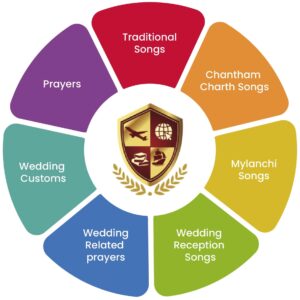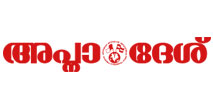
THE KEY PLAYERS IN A WEDDING
Besides the betrothal and marriage ceremony conducted in the church, there are a variety of Knanaya wedding customs that involve the relatives of the bride and groom. This chapter outlines the duties of different family members so that they can be prepared to carry out their roles.
THE GROOM’S SIDE
GROOM
1. The bridegroom attends the marriage preparation course.
2. He shall meet with the parish priest for the wedding paperwork and give the required documents.
3. The groom does the sacrament of confession to prepare spiritually for matrimony.
4. He should practice how to tie the thali with the thread from the manthrakodi.
GROOM’S FATHER
1. He leads the prayer at home and receives “sthuthi” before the groom’s party leaves from home to the church for betrothal.
2. The groom’s father leads the prayer at home and receives “sthuthi” from the groom before the groom leaves to the church for his wedding.
3. He leads the prayer at the beginning of Chantham Charthal.
4. When the bride goes to her home for the first time after the wedding, the groom’s father gives her Illappanam (Clan money) that is for church offering and to help the poor.
GROOM’S MOTHER
1. She receives “sthuthi” from the groom before the groom’s party leaves from home to the church for betrothal and wedding.
2. The groom’s mother does the Nellum Neerum at the entrance of the pandal or banquet hall.
3. If a gold chain is presented to the couple at the Manarkolam, the groom’s mother will adorn the bride with the gold chain, while the bride’s mother will do the same for the groom.
4. After the wedding banquet, the groom’s mother will receive the bride from her mother.
GROOM’S PATERNAL UNCLE(S)
1. He receives “sthuthi” from the groom before the groom’s party leaves from home to the church for betrothal.
2. He claps hands with the bride’s paternal uncle during the betrothal service at the church.
3. At the end of the betrothal, the groom’s paternal uncle receives the bride’s family share from the bride’s paternal uncle.
4. At the Ichappad Ceremony, he wraps his shoulder cloth around the head with both ends facing up and asks permission thrice to give Ichappad to the groom. He then helps the groom to wash his mouth with kindi and kolambi followed by washing his own hands. Then he gives the Ichappad three times in the groom’s mouth.
5. He receives “sthuthi” from the groom before the groom’s party leaves from home to the church for the wedding.
6. During the kacha thazhukal ceremony at the Manarkolam in the wedding pandal, the groom’s paternal uncle places the cloth or sari on the hands of the groom.
GROOM’S MATERNAL UNCLE(S)
1. The maternal uncles of the bride and groom used to come together for the erection of the poles for the pandal (canopy).
2. They receive “sthuthi” from the groom before the groom’s party leaves from home to the church for betrothal.
3. The groom’s maternal uncle accepts the offer of the bride’s maternal uncle to wash the hands before the betrothal meal using kindi and kolambi.
4. They will accept “vazhippukala” from the bride’s maternal uncles at the end of the betrothal meal.
5. They receive “sthuthi” from the groom before the groom’s party leaves from home to the church for betrothal and wedding.
6. The bridegroom’s maternal uncles will lead the first nadavili in front of the church or at the foot of the granite cross after the wedding.
7. They will join the bride’s maternal uncles for the third nadavili at the pandal or banquet hall.
8. The groom’s maternal uncles will take the groom to the entrance of the pandal or stage.
9. After the Nellum Neerum ceremony, the groom’s maternal uncles will escort the newlyweds to their seats (Manarkolam).
10. During the wedding banquet, the groom’s maternal uncle gives water using kindi and kolambi to the bride’s maternal uncles to wash their hands before serving food at the wedding banquet.
11. They also give cooked chicken, during the wedding banquet, to the bride’s maternal uncles.
12. The groom’s maternal uncles will give “vazhippukala” to the bride’s maternal uncles at the end of the wedding traditions.
GROOM’S GRANDPARENTS
They receive “sthuthi” from the groom before the groom’s party leaves from home to the church for betrothal and wedding.
GROOM’S SISTER(S)
1. The groom’s sister receives the thali from the goldsmith holding a lighted koluvilakku (traditional ritualistic lamp). She gives him a gift for his service.
2. She sets up the stool with a white linen covering and lit koluvilakku on the dais for the Chantham Charthal.
3. While the barber is doing the haircut and saving, the groom’s sister brings oil to put on the groom’s hair, hands, and feet.
4. She spreads another new white cloth on the groom’s seat after the barber leaves with the previous cloth on it.
5. She places the Ichappad (venpalchor and jaggery) along with kindi and kolambi near the groom in the pandal prior to offering Ichappad during the Chantham Charthal ceremony.
6. The groom’s sister leads the procession with a lit koluvilakku as the groom’s group departs home to the vehicle for the journey to the church.
7. She assists the bride by moving the veil and hair out of the way while the groom fastens the thali around the bride’s neck.
8. She brings the koluvilakku and a plate with water, seven paddy grains, and a piece of palm leaf for the Nellum Neerum ritual.
9. The bride’s sister holds a plate containing water, grains, and a palm leaf while her mother performs the Nellum Neerum ceremony.
10. She brings kindi with water and kolambi for mouth rinsing of the couple before and after giving Palum Pazhavum.
GROOM’S BROTHER-IN-LAW
1. He brings the groom on the dais and sits on the stool for Chantham Charthal.
2. He leads the groom after Chantham Charthal for bath and returns him after the bath.
3. When the Ichappad ritual is over, he escorts the groom to the house.
THE BRIDE’S SIDE
BRIDE
1. The bride attends the marriage preparation course.
2. She meets with the parish priest for the wedding paperwork and submits all the required documents.
3. She makes the confession to prepare spiritually for the sacrament of matrimony.
BRIDE’S FATHER
1. He leads the prayer at home and receives “sthuthi” before the bride’s party leaves from home to the church for betrothal.
2. After the betrothal, he hands over the packet of money to the bride’s paternal uncle during the bride’s share transaction.
3. The bride’s father leads the prayer at home and receives “sthuthi” before the bride’s party leaves from home to the church for the wedding.
4. He leads the prayer at the beginning of Mailanchi Ideel.
5. When the bride goes to her home for the first time after the wedding, the groom’s father gives her illappanam (Clan money) that is used for church offering and to help the poor.
BRIDE’S MOTHER
1. The bride’s mother receives “sthuthi” from the bride before the bride’s party leaves from home to the church for betrothal.
2. Following the betrothal, when the exchange of the bride’s share at home occurs, the bride’s mother will light a nilavilakku or koluvilakku. During the past, she used to hand over the packet of money to her husband.
3. She receives “sthuthi” from the bride before the bride’s party leaves from home to the church for the wedding.
4. The bride’s mother used to hold the koluvilakku while the groom’s mother did the nellum neerum.
5. The bride’s mother performs the Vazhoo Pidutham and provides the bride and groom with milk and fruit from the same bowl at the Manarkolam.
6. She is the second person to perform the kacha thazhukal and receives a new cloth (sari) from the groom’s family in appreciation for her role in raising the bride.
7. If gold chains are given to the couple at the Manarkolam, the bride’s mother will adorn the groom with the chain, and the groom’s mother will do the same for the bride.
8. After the wedding banquet, the bride’s mother hands over the bride to the groom’s mother.
9. During the past, on the fourth day after the wedding, she visited the bridal chamber to open its door, offering household utensils and ornaments to the newly married couple.
BRIDE’S PATERNAL UNCLE
1. He receives “sthuthi” from the bride before the bride’s party leaves from home to the church for betrothal and wedding.
2. He claps hand with the groom’s paternal uncle during the betrothal service at the church.
3. At the conclusion of the betrothal at the bride’s house, the bride’s paternal uncle requests permission from the audience three times to give bride’s family share to the groom’s family. Afterward, he faces eastward and presents the money to the groom’s paternal uncle.
4. At the Ichappad Ceremony, he wraps his shoulder cloth around the head with both ends facing up and asks permission to give Ichappad to the bride. He then washes his hands and the mouth of the bride with kindi and kolambi. Then he gives the Ichappad three times in the bride’s mouth.
BRIDE’S MATERNAL UNCLE(S)
1. The maternal uncles of the bride and groom used to come together for the erection of the poles for the pandal (canopy).
2. The bride’s maternal uncles receive “sthuthi” from the bride before the bride’s party leaves from home to the church for betrothal and wedding.
3. The bride’s maternal uncle uses kindi and kolambi to help the groom’s maternal uncle wash his hands before the betrothal meal. He caters to the guests who come from the groom’s side.
4. The bride’s maternal uncles will receive “vazhippukala” from the groom’s maternal uncles at the end of the betrothal meal.
5. For Knanaya Jacobite betrothal, the bride’s maternal uncles offer cooked chicken thigh to the groom’s maternal uncles. Some Knanaya Catholics now practice this.
6. The bride’s maternal uncle carries the “thazhakkuda” in front of the procession as the couple and the guests leave the church for the wedding banquet.
7. The bride’s maternal uncles will lead the second nadavili after the wedding when the procession reaches near the pandal or banquet hall
8. They will join the groom’s maternal uncles for the third nadavili at the pandal or banquet hall.
9. The bride’s maternal uncles will take the bride to the entrance of the pandal or stage.
10. The bride’s eldest maternal uncle does the kacha thazhukal first, after getting permission from the audience. He also receives a new cloth as a gift from the groom’s family.
11. The bride’s maternal uncle helps the groom’s maternal uncle to wash his hands using kindi and kolambi before serving the meal at the wedding banquet.
12. The bride’s maternal uncles will receive cooked chicken thigh from the groom’s maternal uncle at the wedding banquet.
13. The bride’s maternal uncles will receive “vazhippukala” from the groom’s maternal uncles at the end of the wedding traditions.
BRIDE’S GRANDFATHER
He receives “sthuthi” from the bride before the bride’s party leaves from home to the church for betrothal and wedding.
BRIDE’S GRANDMOTHER
1. She receives “sthuthi” from the bride before the bride’s party leaves from home to the church for betrothal.
2. The bride’s grandmother applies the Mailanchi paste on the hands and foot nails of the bride during the Mailanchi Ideel (Henna) ceremony.
3. She receives “sthuthi” from the bride before the bride’s party leaves from home to the church for the wedding.
4. The bride’s grandmother is the third person to do the kacha thazhukal and receives a cloth (sari) as a gift from the groom’s family.
BRIDE’S SISTER(S)
1. At the start of Mailanchi Ideel, the bride’s sister sets up two stools (kurandikal) on the dais and covers them with a new white cloth.
2. She then brings a lighted nilavilakku or koluvilakku to the dais for the betrothal.
3. The bride’s elder sister escorts the bride to the pavilion for Mailanchi Ideel.
4. She places the green henna paste near the bride.
5. She brings kindi that contains water, kolambi, and Ichappad on stage.
6. After the Ichappad, she takes the bride inside the house.
7. The bride’s sister leads the procession with a lit koluvilakku as the bride’s group departs home to the vehicle for the journey to the church.
PRIEST
1. The parish priests of the groom and bride prepare them spiritually for the wedding.
2. They do the canonical procedures for the wedding, including publication of wedding banns and exchange of necessary letters.
3. They celebrate the betrothal and bless the marriage.
4. They record the betrothal and marriage in the parish registers.
GOLDSMITH
The goldsmith prepares a thali for the wedding and brings it to the groom’s house before the Chantham Charthal and hands it over to the groom’s sister on a betel leaf placed over rice on a plate.
BARBER
1. The village barber asks permission thrice from the audience before entering the pandal to do his role during the Chantham Charthal.
2. He does ritualistic shaving and haircutting during the Chantham Charthal.
3. He asks permission thrice before massaging the groom with oil.
4. The barber massages the groom with oil on hair and body as part of the Chantham Charthal.
5. He takes the leftover oil, the white cloth on the kurandi and receives a gift from the groom’s family and leaves the pandal.
PAANAN
The Paanan sings the songs praising Thomas of Kinai after the Chantham Charthal.
PREPARED BY FR. ABRAHAM MUTHOLATH

The Knanayology Foundation (Knanaya Global Foundation NFP), a non-profit organization registered in IL, USA, hosts Knanayology and undertakes other projects on Knanaya Community .







